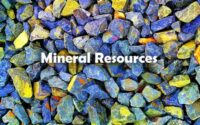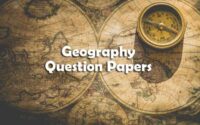Bio Geography Questions and Answers
Bio Geography Questions and Answers Papers pdf will be available here for download. Therefore, all the contenders can make use of this chance and start to download the Bio Geography Solved Question Papers. Because by solving the Bio Geography Objective Model Papers you can improve your knowledge.

Also, check for download the Bio Geography MCQ Papers with Solutions from the link provided below. The Bio Geography Quiz helps you to prepare well for the exam topic wise and obtain very good marks. Therefore, go through this post thoroughly and download the Bio Geography Last Year Question Papers.
All these questions on Bio Geography are collected from previous year papers and compiled by us.
Questions and Answers on Bio Geography
1. A natural region has the similarity of
(A) climate and natural vegetation
(B) climate and occupation
(C) soil and drainage
(D) economic base and recess
2. Global warming is expected to result in
(A) Increase in level of sea
(B) Change in crop pattern
(C) Change in coastline
(D) All of the above
3. Man can maintain an ecological balance in the biosphere by
(A) Deforestation
(B) developing new breeds of cultivated plants and domesticated animals
(C) using insecticides and pesticides
(D) understanding the delicate balance in the relative number of organisms
4. Which of the following exhibits unidirectional flow in an ecosystem?
(A) Light
(B) Energy
(C) Water
(D) Biomass
5. Which of the following exhibits unidirectional flow in an ecosystem?
(A) Light
(B) Energy
(C) Water
(D) Biomass
6. Rubber plantations are found in
(A) Temperate forests
(B) Mountain regions
(C) Polar regions
(D) Equatorial regions
7. “Tidal forest” is otherwise called :
(A) Evergreen forest
(B) Monsoon forest
(C) Mangrove forest
(D) Coniferous forest
8. All the ecosystems taken together in a geographical area form a bigger unit called:
(A) Biosphere
(B) Territory
(C) biome
(D) community
9. The word Biosphere refers to :
(A) Zone of soil, water and air around earth capable of supporting the flora and fauna.
(B) Part of earth surface which can support the flora
(C) Parts of air around earth a where life can exist
(D) Zone of water on earth which can support life.
10. Which of the following metals contribute to biomagnification problem in the ecosystem ?
(A) Mercury
(B) Chromium
(C) Copper
(D) Lead
11. What is the percentage coverage of Tropical Forest on earth’s landmass ?
(A) 7
(B) 12
(C) 17
(D) 25
12. The fur of the animals living in colder regions
(A) protects them from water
(B) traps the air and keeps them warm
(C) protects them from enemies
(D) makes them appear beautiful
13. Which of the following phenomena is supposedly associated with global warming ?
(A) Southern Oscillations
(B) El Nino
(C) La Nino
(D) El Nino Modiki
14. Which of the following is a renewable resource ?
(A) Coal
(B) Mineral oil
(C) Natural gas
(D) Forests
15. Taiga means :
(A) Decidious forests
(B) Coniferous forests
(C) Grass lands
(D) Deserts
16. Virtually treeless, sparse vegetation is found in :
(A) Taiga
(B) Alpine
(C) Tundra
(D) Chapparal
17. ‘Green Accounting’ means measuring the National Income of the country taking into account estimation of
(A) the total forest area of the country
(B) the destruction of forest cover of the country
(C) pollution and environmental damage
(D) area of reclaimed fallow land
18. Which one of the following is an abiotic and renewable resource?
(A) iron ore
(B) livestock
(C) water
(D) forests
19. The largest ecosystem of the Earth is
(A) Biome
(B) Hydrosphere
(C) Lithosphere
(D) Biosphere
20. An artificial ecosystem is represented by :
(A) pisciculture tank
(B) agricultural land
(C) zoo
(D) aquarium
| Physical Geography | Atmosphere |
| Bio Geography | Earth landform |
| Soil Geography | Universe and Solar System |
| Hydrosphere |
21. Which is the most stable ecosystem ?
(A) Desert
(B) Ocean
(C) Mountain
(D) Forest
22. An ecosystem consists of :
(A) producers, consumers and decomposers in a particular area.
(B) all the plants and animals of an area.
(C) a living community and its environment.
(D) carnivorous and herbivorous of an area
23. Which one of the following is a greenhouse gas?
(A) Oxygen
(B) Nitrogen
(C) Carbon-di-Oxide
(D) Ozone
24. An ecological system is a
(A) Biological system
(B) Biogeochemical system
(C) Physicochemical system
(D) Bioecological system
25. In predation between
i. A lion and a deer
ii. A snake and a frog
iii. A lizard and an insect and
iv. An owl and a rat
26. Which predator will have greater control over its prey?
(A) Lion
(B) Owl
(C) Snake
(D) Lizard
27. After which one of the following tribes of India, has a large continent of ancient geological history of the world been named?
(A) Santhals
(B) Bhils
(C) Marias
(D) Gonds
28. Evergreen rain forest is mainly found in regions having well distributed annual rainfall
(A) Below 50 cm
(B) 50-100 cm
(C) 100-200 cm
(D) More than 200 cm
29. Mangrove forests occur in
(A) high mountains
(B) snowy plains
(C) coastal swamps
(D) interior plateaus
30. Name the condition which influences the development of plants into distinctive forms.
(A) Climatic conditions
(B) Soil conditions
(C) Environmental conditions
(D) Social conditions
31. Species which has restricted distribution is called
(A) Eco species
(B) Endemic
(C) Sympatric
(D) Allopatric
32. The space retaining life in any form is called
(A) Biomass
(B) Biosphere
(C) Lithosphere
(D) Hydrosphere
33. Which of the following is a Biological method of soil conservations?
(A) Contour farming
(B) Contour terracing
(C) Gully control
(D) Basin listing
34. With what bio-region is the term ‘‘Steppe’’ associated ?
(A) Grasslands
(B) Tropical forests
(C) Savanna
(D) Coniferous forests
35. Tropical rain forest is characterised by
(A) Absence of trees
(B) Least productivity
(C) Maximum biodiversity
(D) Minimum biodiversity
36. Natural sources of air pollution are
(A) Forest fires
(B) Volcanic eruptions
(C) Dust storm
(D) Smoke from burning dry leaves
37. Which one of the following is the correct sequence of ecosystem in the order of decreasing productivity?
(A) Oceans, mangroves, lakes, grassland
(B) Mangroves, oceans, grassland, lakes
(C) Oceans, lakes, grassland, mangroves
(D) Mangroves, grasslands, lakes, oceans
38. Vergreen type Forests are found in :
(A) Mediterranean region
(B) Monsoon climatic area
(C) Desert region
(D) Equatorial region
39. The maximum biodiversity is found in
(A) Tropical rain forests
(B) Temperate forests
(C) Coniferous forests
(D) Arctic forest
40. In _______ forests, trees shed their leaves in a particular season.
(A) Evergreen
(B) Mangrove
(C) deciduous
(D) thorny
41. Biosphere refers to
(A) the area of the land inhabited by living organism
(B) the part of ocean inhabited by plants and animals
(C) the portion of the earth, including the oceans, the land, the soil and the atmosphere inhabited by living organisms
(D) the atmosphere surrounding the living organisms
42. To which natural vegetation belt do Sal and Teak trees belong ?
(A) Temperate forests
(B) Equatorial forests
(C) Tropical deciduous forests
(D) Mixed forests
43. The distribution of characteristic vegetation of a region is determined mainly by
(A) soil, water and temperature
(B) water, greenhouse effect and altitude
(C) wind, water and latitude
(D) sunlight, water and wind
44. What makes an ecosystem ?
(A) A living community and its environment
(B) All the plants and animals of an area
(C) Carnivores and herbivores of an area
(D) Producers, consumers and decomposers in a particular locality
45. Source of energy in ecosystem is
(A) Sun
(B) Green plants
(C) Sugar produced in photosynthesis
(D) ATP
46. The area reserved for the welfare of wild life is called :
(A) Sanctuary
(B) Forest
(C) National Park
(D) Botanical garden
47. There is a need to keep larger area under forests for :
(A) absorption of carbon dioxide
(B) protecting wildlife
(C) raising precipitation
(D) geological balance
48. Dumping of solid waste in following areas earth cover is called as :
(A) Sanitary landfilling
(B) Open dumping
(C) Composting
(D) Incineration
49. The cause of loss of forest cover is
(A) Agriculture
(B) Building Industry
(C) Increasing population
(D) Tourism & pilgrimage
50. ‘Green House Effect’ means
(A) Pollution in houses in tropical regions
(B) Trapping of solar energy due to atmospheric oxygen
(C) Trapping of solar energy due to atmospheric carbon dioxide
(D) Cultivation in green houses so as to check pollution
51. Which of the following phenomena is supposedly associated with global warming ?
(A) El Nino
(B) La Nina
(C) El Nino Modoki
(D) Southern Oscillation


